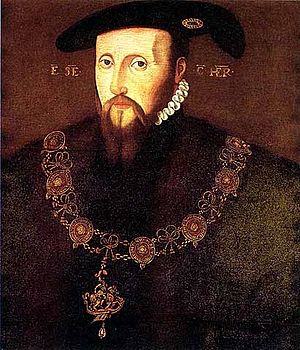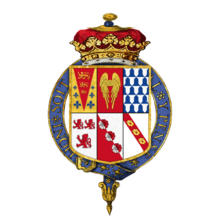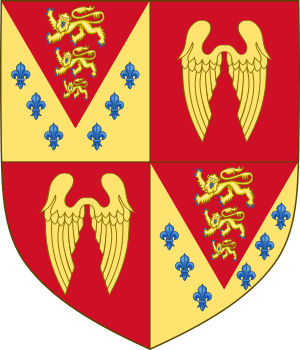Edward Seymour, 1st Duke of Somerset facts for kids
Quick facts for kids
The Duke of Somerset
|
|
|---|---|

Portrait of Edward Seymour as 1st Earl of Hertford (cr 1537), wearing the Collar of the Order of the Garter. By unknown artist, Longleat House, Wiltshire.
|
|
| Lord High Treasurer | |
| In office 10 February 1547 – 10 October 1549 |
|
| Monarch | Edward VI |
| Preceded by | The Duke of Norfolk |
| Succeeded by | The Marquess of Winchester |
| Lord Protector of the Realm | |
| In office 4 February 1547 – 11 October 1549 |
|
| Monarch | Edward VI |
| Lord Great Chamberlain | |
| In office c.1543–c.1549 |
|
| Monarch | Henry VIII Edward VI |
| Preceded by | The Earl of Sussex |
| Succeeded by | The Earl of Warwick |
| Personal details | |
| Born | 1500 |
| Died | 22 January 1552 (aged 51–52) Tower Hill, London |
| Cause of death | Decapitation |
| Resting place | Chapel Royal of St. Peter ad Vincula, Tower of London, London, United Kingdom 51°30′31″N 0°04′37″W / 51.508611°N 0.076944°W |
| Nationality | English |
| Spouses | |
| Children | with Catherine:
|
| Parents | |
| Residences |
|
| Signature |  |
| Military service | |
| Allegiance | Kingdom of England |
| Battles/wars |
|
Edward Seymour, 1st Duke of Somerset (1500–22 January 1552), also known as Edward Semel, was a powerful English nobleman. He was the older brother of Jane Seymour, who became the third wife of Henry VIII, the King of England.
After King Henry VIII died, Edward Seymour became the Lord Protector of England. This meant he ruled the country from 1547 to 1549 because his nephew, Edward VI, was too young to be king. Even though many common people liked him, his decisions often made the wealthy nobles angry. This eventually led to his downfall.
Contents
Early Life and Career
Edward Seymour was born around 1500. His father was Sir John Seymour and his mother was Margery Wentworth. When he was about 14, he joined the household of Mary Tudor, who was the Queen of France at the time.
He served in military campaigns in France in 1523 and was made a knight. He also traveled with Thomas Wolsey, a very important church leader, to France in 1527. In 1529, he became an Esquire of the Body for King Henry VIII. This was a special role, meaning he was a personal attendant to the king. He grew close to the king, who even visited his home in 1535.
Rising to Power Under Henry VIII
Edward Seymour's influence grew a lot when his sister, Jane, married King Henry VIII in 1536. He was given important titles like Viscount Beauchamp and Earl of Hertford. He also became the Warden of the Scottish Marches, which meant he was in charge of defending the border with Scotland. He remained a favorite of the king even after his sister Jane died in 1537.
In 1541, while King Henry was away, Hertford, along with other important figures, managed affairs in London. In 1542, he became the Warden of the Scottish Marches again. A few months later, he was briefly the Lord High Admiral of the United Kingdom, in charge of the navy.
In 1544, he led an army into Scotland to punish them for breaking a marriage agreement. He landed at Leith, captured and looted Edinburgh, and burned villages on his way back. Later that year, he was put in charge of England while Henry was fighting in France. He then joined the king at the surrender of Boulogne.
In 1545, he was sent back to Scotland to get revenge for a Scottish victory. He led a fierce attack, burning many towns and crops. In 1546, he was involved in peace talks with France.
Towards the end of King Henry's reign, Edward Seymour was a key figure in the competition for power. He and his allies were rivals with the Howard family. This rivalry led to the downfall of the Howards, including the execution of the Earl of Surrey and the imprisonment of the Duke of Norfolk.
Seymour as Lord Protector
The New King and Council
When King Henry VIII died in January 1547, his young son became King Edward VI. Henry's will named sixteen people to act as Edward's Council until he turned 18. These people were supposed to rule together.
However, just a few days after Henry's death, the Council chose Edward Seymour to have almost king-like power. They made him the Lord Protector of the Realm and the Governor of the King's Person. He also made himself the Duke of Somerset. This gave him a lot of control over the government.
Seymour quickly took charge. He was able to appoint people to the Privy Council (the king's main advisors) and often made decisions on his own. He ruled mostly by issuing official announcements, with the Council simply approving his choices.
Conflict with Thomas Seymour
Edward Seymour faced problems from his own younger brother, Thomas Seymour. Thomas wanted more power, especially to be in charge of the young King Edward. Edward tried to give his brother important titles and a place on the Council, but Thomas kept plotting. He secretly gave King Edward pocket money and told him that the Duke of Somerset was too strict with money.
In January 1549, the Council arrested Thomas Seymour for various reasons, including misusing money. King Edward himself spoke about the secret pocket money. Thomas was found guilty without a trial and was executed on 20 March 1549.
Wars and Rebellions
Edward Seymour was a skilled soldier. He had proven this in his campaigns against Scotland and in defending Boulogne. As Protector, his main goal was to win the war against Scotland. After a big victory at the Battle of Pinkie in September 1547, he set up military bases across Scotland.
However, his plan to unite England and Scotland through war became difficult. Scotland allied with France, who sent help. The young Mary, Queen of Scots, was sent to France to marry the French prince. Also, keeping so many soldiers in Scotland was very expensive for England. A French attack on Boulogne in 1549 forced Seymour to start pulling his troops out of Scotland.
In 1548 and 1549, England faced many protests and rebellions. These were caused by religious changes and problems with land. The two biggest rebellions were in Devon and Cornwall (the Prayer Book Rebellion) and in Norfolk (led by Robert Kett). The Prayer Book Rebellion was mainly about the new English church services. Kett's Rebellion was mostly about wealthy landowners taking over common land.
Many people who protested believed that Edward Seymour supported them against the landowners. This was partly because he issued some confusing announcements and sent out groups to investigate complaints about land issues. However, the widespread unrest showed that the government was failing, and the Council blamed Seymour.
Loss of Power
By October 1549, Edward Seymour knew his rule was in danger. He issued a call for help, took King Edward with him, and went to the fortified Windsor Castle for safety. King Edward later said he felt "in prison" there.
Meanwhile, the Council announced details of Seymour's poor leadership. They made it clear that his power came from them, not directly from King Henry VIII's will. On 11 October, the Council arrested Seymour and brought the king to Richmond Palace. King Edward wrote that his uncle was accused of "ambition, vainglory, entering into rash wars... enriching himself of my treasure, following his own opinion, and doing all by his own authority."
In February 1550, John Dudley, Earl of Warwick, became the new leader of the Council. Edward Seymour was released from the Tower and allowed back on the Council for a short time. However, in October 1551, he was sent back to the Tower on charges of trying to overthrow Dudley's government. He was executed on 22 January 1552, on Tower Hill in London. King Edward wrote in his diary that his uncle "had his head cut off upon Tower Hill between eight and nine o'clock in the morning." Edward Seymour was buried at the Church of St Peter ad Vincula in the Tower of London.
Family Life
Edward Seymour was married twice.
- His first wife was Catherine Fillol. They had two sons:
- John Seymour (1527–1552). He was sent to the Tower with his father and died there.
- Lord Edward Seymour (1529–1593). He was also imprisoned but later released. He inherited land from his brother.
- His second wife was Anne Stanhope (c. 1510–1587). They had ten children:
- Edward Seymour, Viscount Beauchamp of Hache (1537–1539). He died as a young child.
- Lady Anne Seymour (1538–1588).
- Edward Seymour, 1st Earl of Hertford (1539–1621). He was given the title Earl of Hertford by Queen Elizabeth I.
- Lord Henry Seymour (born 1540).
- Lady Margaret Seymour (born 1540), who was a writer.
- Lady Jane Seymour (1541–1561), who was a Maid of Honour to Queen Elizabeth I and also a writer.
- Lady Catherine Seymour.
- Lady Mary Seymour (born 1542).
- Lord Edward Seymour (1548–1574).
- Lady Elizabeth Seymour (1552–1602).
The direct male family line from Edward Seymour and Anne Stanhope ended in 1750. After that, the descendants of Edward Seymour's first wife, Catherine Fillol, inherited the title of Duke of Somerset.
Images for kids
See also
 In Spanish: Edward Seymour, I duque de Somerset para niños
In Spanish: Edward Seymour, I duque de Somerset para niños



